
An alternator is the heartbeat of the automobile electrical system. It converts mechanical energy into electrical energy in the form of an alternating current. This allows a vehicle to charge the battery and power the electrical system while the automobile is running. The alternator is a very rugged piece of equipment but can be damaged by excessive heat or voltage overloads.
Open the hood of the car and inspect the belt that is attached to alternator. If the belt is loose or has a crack the alternator will not work properly.
Start the car and allow it to run idle for 3 to 5 minutes. Keep the hood open, as you will need access to the battery after you turn off the engine.
Attach a voltmeter to the battery terminals and turn it on. The voltage should read 14.2 volts when the car is running in the idle position. A voltmeter can be purchased at most auto parts stores.
Enter the vehicle and sit in the driver's seat. Turn on the headlights and the radio while the car is running and the voltmeter is attached to the battery. Check the reading of the voltmeter again; it should read 13 volts.
Increase the engine speed to 2000 RPM and have someone read the voltmeter. It should read 14 volts when the engine is operating at this velocity. A reading lower than 14 volts, or higher than 14.4 volts, indicates a problem with the alternator.